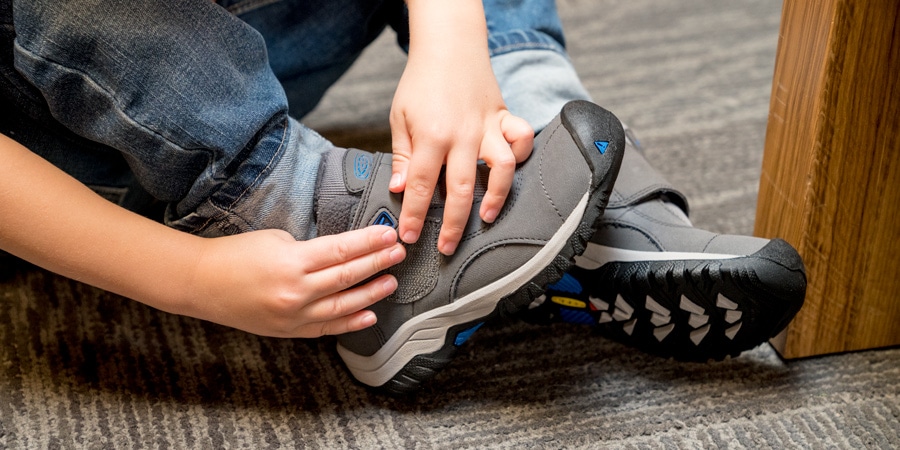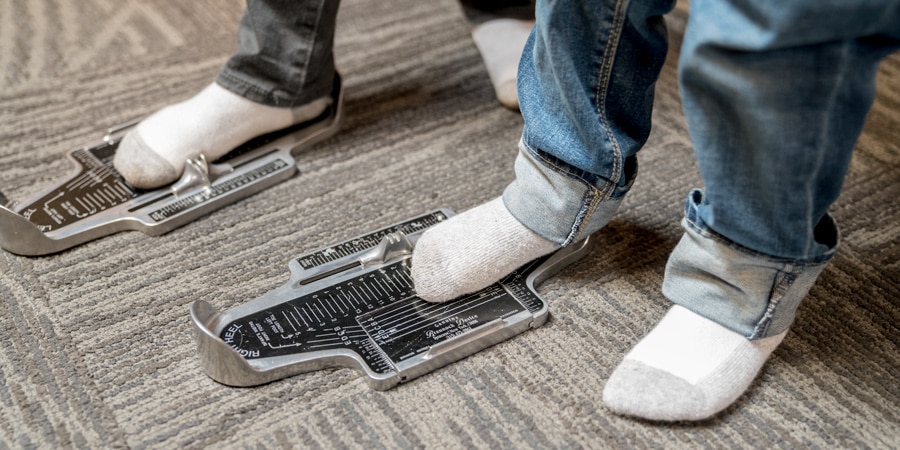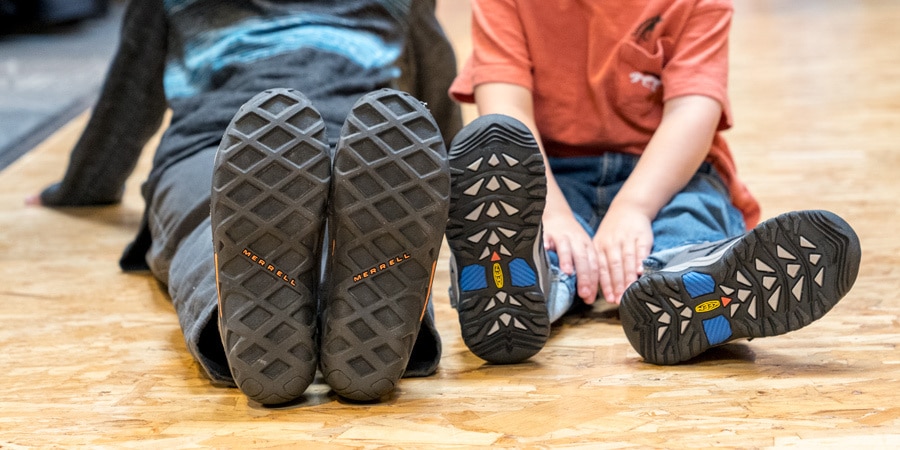For many parents, grandparents and other adults, keeping up with kids' quickly growing feet can be not only costly but also confusing. Overlapping size charts and inconsistent language used by brands and retailers to describe kids' footwear can make it difficult to figure out just what size shoes your child needs. In this article, we clear things up with a close look at kids' shoe sizes and we provide several helpful fit tips.
Kids' Shoe Sizes by the Numbers

Shopping for kids' shoes doesn't seem like it should be overly difficult, but, unfortunately, figuring out kids' shoe sizes can often be a confounding process. To help clear things up, here are the most important things to understand about kids' shoe sizes:
Toddlers' sizes run from 0-13: The smallest sizes in this range are tiny baby shoes, but the larger sizes often fit kids who are 4 or 5 years old or even older. Important: These shoes are often marked with "T" for toddler up to size 7 (e.g., 4T, 5T, 6T, 7T). Sizes 8-13 are typically marked with "Kids" (e.g., 8 Kids, 9 Kids, 10 Kids, etc.).
Bigger kids' sizes run from 1-7 (or up to 6 with some brands): Here's where lots of parents get tripped up. Shoes for bigger kids start at size 1 and run up to 7, creating the confusing fact that a size 1 shoe (in big kids' sizes) is the next size up from a size 13 shoe (in little kids' sizes). Sometimes shoe brands will help you out by having their 1-7 toddler sizes marked with "T" and their other sizes designated as "Kids." That's how you tell little toddler shoes from kids' shoes even if they have the same number. For example, if you see a shoe that's available in size "5 Kids," you know that's the bigger kids' 5, not a toddlers' 5.

Not all brands and retailers use the same language: On top of the confusing overlap of toddlers' and kids' sizes, brands and retailers like to use different terms to describe toddlers' and kids' shoes, making it challenging to know exactly what you're looking at. The variety of terms you're likely to see include, baby, walker, toddler, little kid, big kid and youth. Terms like baby, walker, toddler and little kid usually apply to the toddlers' sizes ranging from 0-13, while other terms, like big kid and youth, tend to apply to kids' sizes 1-7. At REI, we generally stick to the terms toddlers (or tots) and kids.
Men's sizes are a continuation of kids' sizes: A men's size 8 is the next full size up from a kids' 7. This can be helpful to know if your child is outgrowing kids' shoes. It can also be beneficial to know that there's approximately a 1.5 size difference between men's and women's shoes, meaning a men's 8 is roughly equal to a women's 9.5.
A size chart can help: Whenever you're shopping, try to find a size chart associated with the brand of shoes you're interested in. That will help you figure out the relationship between toddlers' sizing and kids' sizing and the naming conventions to look for. For reference, here's a common size chart you might see for toddlers' and kids' footwear:
Toddlers' and Little Kids' Shoe Size Chart
| 4T | 5T | 6T | 7T | 8 | 9 | 10 | 11 | 12 | 13 | |
|---|---|---|---|---|---|---|---|---|---|---|
U.S. Kids' | 4 Tots' | 5 Tots' | 6 Tots' | 7 Tots' | 8 Kids' | 9 Kids' | 10 Kids' | 11 Kids' | 12 Kids' | 13 Kids' |
EU | 19 | 20-21 | 22 | 23 | 24 | 25-26 | 27-28 | 29 | 30 | 31 |
UK | 3 | 4 | 5 | 6 | 7 | 8 | 9 | 10 | 11 | 12 |
Big Kids' Shoe Size Chart
| 1 | 2 | 3 | 4 | 5 | 6 | |
|---|---|---|---|---|---|---|
U.S. Kids' | 1 Kids' | 2 Kids' | 3 Kids' | 4 Kids' | 5 Kids' | 6 Kids' |
EU | 32-33 | 34 | 35 | 36 | 37 | 38 |
UK | 13 | 1 | 2 | 3 | 4 | 5 |
How Should Kids' Shoes Fit?

Kids' feet grow quickly, so whether or not you're in the market for new shoes, it's important to stay in touch with how well their shoes fit. Here are some things to keep in mind as you check the fit of their shoes:
How to Measure Kids' Feet
Measure frequently: You should definitely measure children's feet every time they get new shoes, especially if you're buying them for active uses like hiking or running around the playground. Also, even if you don't think your child needs new shoes, it's not a bad idea to have a qualified shoe expert measure both their feet a couple times a year to stay on top of things. And be sure to re-measure anytime your child complains that their shoes are bothering them. Measuring for overall length is important, of course, but a true fit expert will also measure foot width and arch length and do a volume assessment. These things give a more complete picture of what size shoes will work best for your child's feet.
Measure against the insoles: The age-old test of pressing on the tip of a shoe with your thumb to see how much room is in your child's shoe can work sometimes, but if you're having trouble with that, remove the shoes, take the insoles out and set them on the floor. Then have your child stand on the insoles with their heels and arches in the proper places. This makes it super easy to see how much space there is up front. In general, it's good to have about a half an inch or a little more.
Additional Fit Tips for Kids' Shoes
Check in with your kids: If they complain that their feet are bothering them, then it's time to take a look at how their shoes are fitting. They may be in the wrong size.
Sometimes kids won't tell you that their shoes are bothering them until you ask, so it's good to check in a couple times a year. And when you do, be specific with your questions about fit. Ask things like, "Do your shoes squeeze here?" or "Does your foot move around here?" while pointing to a spot on the foot. Not all kids will know how to respond to the more general question, "Do your shoes fit well?"
Consider adult shoes if your kid weighs more than 80 pounds: If your child weighs more than this and can fit into adult shoes then they should make the jump up. Kids' shoes just aren't built to provide the necessary support for heavier loads. This is also important to understand if you're an adult with small feet and looking to save some money by purchasing kids' shoes. You'll save some cash, but your feet might not be happy about it.
Consider women's shoes when moving out of kids' sizes: As your child begins to grow out of kids' shoe sizes, consider looking at women's shoes for greater variety and availability. For example, it can be difficult to find size 7 kids' or men's shoes, but it may be possible to find equivalent styles in a women's size 8.5. Just keep in mind that you'll pay more for adult-size shoes.
For more fit tips, see our blog post, How to Get a Great Fit in Running Shoes.
